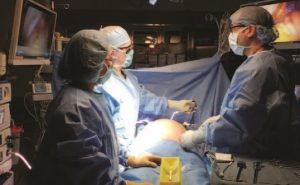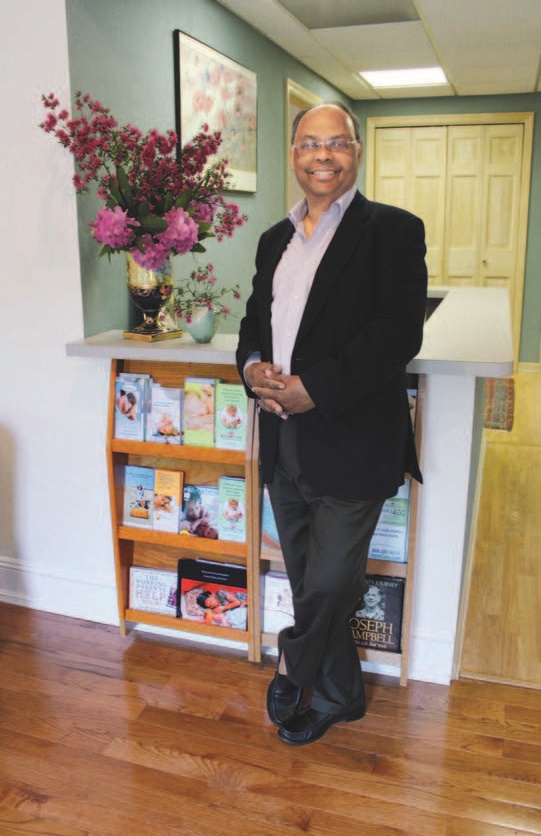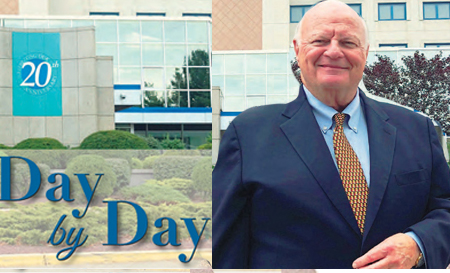Moving Trintas forward is a 24/7 job. I wouldn’t have it any other way.
Gary S. Horan
Quite a bit has changed regarding the healthcare landscape in the decade since EDGE magazine began publication, but to me those 10 years only represent the “second half” of the Trinitas story. It was actually 20 years ago that the final touches were being put on the merger between Elizabeth General Medical Center and St. Elizabeth Hospital to create Trinitas Regional Medical Center, in January of 2000. I came aboard as CEO in the summer of 2001 and, thinking back, I am struck by how my duties and focus, and the hospital itself, have evolved over that time.
The merger was still fresh when I arrived. By that I mean we were still operating with two separate buildings and two separate organizations, and there was anxiety in Elizabeth—the state’s fourth-largest city— about the prospect of closing one institution down and assimilating it with the other. Would Trinitas have the capacity to serve the community?
That turned out to be a non-issue. The decision to merge proved to be a very appropriate and prescient one. The individuals involved had the insight and vision to see that the healthcare environment was changing. They understood that merging was the way to achieve economies of scale and avoid duplication of equipment and technology. And because of that, Trinitas was able to invest in renovations and expansions that have maximized the impact of the new technologies and protocols that have come along in the years since. The capacity was there because of new treatments and medications, which shorten patient stays or prevent them from having to be admitted at all— advances in healthcare that were developed specifically to reduce hospitalization. The 2000s have been a very dynamic, innovative time in healthcare and the merger enabled us to leverage all of these benefits. It also enabled Trinitas to be more nimble and responsive as times changed.
Now, mergers are fairly commonplace among hospitals. But the idea was new in 2000. And it was accomplished during an era of considerable uncertainty. We had all just “survived” Y2K, which sounds like a small deal, but it was a big one at the time. People were afraid that bank accounts would be erased, traffic lights would stop functioning and planes would fall out of the sky. Even though nothing happened, hospitals had to take these threats seriously. A lot of the time and energy and preparation went into “what-if” scenarios. Then, just a couple of months after I came to Trinitas, the terror attacks of 9/11 occurred. Details of that day are still very fresh in mind. From the top floor and rooftop of the medical center we had a clear view of the World Trade Center. To see it burn and see it fall was incredibly sobering to witness. But I also remember how quickly we were able to react: Our emergency services team assembled quickly and, in coordination with the county and the state, dispatched ambulances to Port Liberte in Jersey City to accept the patients who everyone anticipated coming by ferry from downtown. And there were no patients. It was a sad thing. All of the professionals were there waiting and nobody came,
If there was any kind of silver lining to that terrible day, it was that we had done a great job fine-tuning our emergency preparedness—and that people took notice. Right after that, I believe we were one of the first hospitals in the state to participate in the biological warfare training exercise by the Department of Defense. That was quite an experience. We had decontamination tents and everybody had to gown up. It was reassuring to know that we would be prepared if that type of attack occurred. Everybody rose to the occasion—Trinitas staff, the city, the state. The coordination was fantastic. It showed me that people really rise to the occasion in a crisis. And improving our preparedness is something we have continued to do ever since. It’s part of our team-building culture.
Of course, some things I knew would not change. Today, as in 2001, financial viability remains one of my top concerns and challenges. We are still serving a significant charity-care population, a large population of undocumented residents, and a large Medicaid population. And dealing with insurance companies hasn’t gotten easier or less complicated.
Insurance companies—and this goes beyond 20 years—have systematically ratcheted down reimbursement, not just for hospitals but also for doctors. Different plans have come into effect for the consumer during the Obamacare/Affordable Care Act era that were supposed to cover everybody. But as it’s played out, deductibles are very high and the quality of the insurance product is not as robust. People may have seen a reduction in premiums, yet with those savings came a very significant increase in deductibles—which means when they get ill, they can expect to receive big bills at the end of the day.
That forced a lot of doctors to go out of network, which is a very big problem. Two decades ago that was not the case. But in the last four or five years, I feel like I hear more frequently doctors say, “I’m not going to accept any insurance”—in some cases, including Medicare, because the reimbursements are so low. When they see patients out of network, they send them very large bills, and then the patients have to battle that out with their insurance carrier to see how much gets paid. More times than not, only a fraction gets paid and the consumer is left holding the bag for the rest. And then the hospital and the doctor have to deal with them when they struggle to pay.
As a hospital CEO and president, I feel the same anxiety and frustration about our relationship with insurance companies. It’s a difficult one. For instance, it’s increasingly prevalent for insurance companies to deny days to the hospital and deny payments—and the hospital has to go through the hammers of hell to appeal these cases. The thing about it is that, in our appeals, we have an approximately 65% or 70% success rate. That might lead one to believe that the denials are not really looked at from the standpoint of justifiable denials, but a strategy of denying something just to see what happens. It’s an accounting strategy, essentially.
For our part, it’s wonderful to win a high percentage of appeals. When we challenge a denial or expedite an approval, we are advocating for our patients and the best outcomes. However, what people don’t realize is that to appeal is very costly to Trinitas. The amount of money we have to set aside to counter and challenge insurance company denials is staggering. This also includes the work we have to do to get certifications and pre-certifications for certain tests and procedures. This delays treatment in many cases, which is very stressful for the patient…who in many cases blames us!
Returning to happier thoughts, I would say that I have seen remarkable strides in quality control over the past two decades. Patient safety has always been at the forefront for Trinitas and all healthcare institutions— making sure your policies, procedures and products are of the highest quality—and that is top-of-mind here every day. In the old days, hospitals tended to operate on a volume-based system. Now it’s a value-based system. The results and outcomes for patients is far more important in the running of a hospital than it was 20 years ago. You see this reflected in the mergers and acquisitions in healthcare, which have increased dramatically since we did it. Trinitas was one of the first truly successful mergers in the state. And it has certainly stood the test of time from the standpoint of success.
That success has enabled Trinitas to impact the lives of patients far beyond our immediate area. For instance, we are in 80 different locations throughout the state and in every county when it comes to behavioral health. Our presence is well known and our reputation has grown dramatically—people don’t look at us as a single hospital, they look at us as a system. And we are our own system, in that regard. Our Centers of Excellenceextend our reach to a wide audience. We have the professional talent, we have the technology available, and we focus on these areas to ensure that they continue to be Centers of Excellence. Many draw patients from Union County and beyond because we provide services others don’t. And even where others do, we are known for our high-quality patient care and good outcomes.
Take our Wound Care Center, which has three hyperbaric chambers. We get patients from all over the state and the region with complex wounds—often as referrals from other wound centers, because they are having difficulty curing a wound. A few years ago, there was a story in this magazine about a patient who traveled here from Delaware every day for at least 10 weeks. He was originally told that he’d probably lose his leg, and we cured him.
These stories make the dull-but-necessary duties of a hospital CEO bearable. Peter Drucker, the legendary management guru, identified managing a medical center as the most difficult job in the world. You won’t get an argument from me. Trinitas is an incredibly complex organization. Healthcare is very complex. I can probably speak for my peers at other institutions when I say that I would like to spend fewer hours working on issues of regulation and bureaucracy and more time developing new ideas. There are so many new regulations, and often regulations change without much notice. So I often have to shuffle things in order to change quickly to meet those requirements. Obviously, I rely greatly on our compliance people. Compliance is one of the other things, by the way, that has changed over the last 20 years in our industry. It is increasingly a part of everything we do. Not that we have a diminished focus on items such as strategic planning, but with less regulation and bureaucracy, we would have more time to concentrate on more productive things.
If you’ve made it this far, you’re probably wondering what I enjoy most about my job.
I enjoy the planning process—coming up with new ideas, new concepts, new ways to make sure we are providing the community with what it needs (as opposed to what we need). When we develop initiatives, I try to be “risk-assertive,” which means I like to try new things—more so, perhaps, than many of my colleagues. I believe it is important to take a good risk when it is based on good information and, to certain risks like that to deliver good healthcare and have the community on your side.
I also enjoy seeing where new ideas come from. At Trinitas, they come from every corner of the hospital— doctors, nurses and employees in every department. Management and staff meet on a regular basis and a lot of ideas are generated by those interactions, especially where the work environment is concerned. The people who work here have so many ideas of how to be more productive. Our physicians bring us ideas about new technologies we should consider using. An example of that is electroconvulsive therapy. It’s been around a while but it was something we hadn’t done. Our physician staff has been talking a lot about ECT and I think it’s a program we’ll be going into in 2020. Many ideas come from the management team, of course, and also from the outside community.
My job is to keep things running smoothly at Trinitas because, when everything runs smoothly in a hospital, you can put new ideas into action. Some lead to small improvements, while others turn out to be game- changers. You never know when the next big thing will come across your desk. That’s why I listen to all ideas. No one is shut down.
The dynamic healthcare environment was certainly reflected in the announcement we made just as EDGE was going to press: that Trinitas took the first step toward becoming a part of the Robert Wood Johnson Barnabas Health network. Our respective Boards signed a Letter of Intent that provides a basic understanding of future governance and details will be determined over the next few months. Should this transaction go through, Trinitas will remain a full-service, Catholic medical center. I see our eventual move into the RWJBarnabas Health system as an extremely positive and exciting development for our institution— one that will give us the resources and opportunities to greatly enhance the already high level of care we provide to our community.











